Last winter, I got a call from a client whose garage door had jammed halfway during a storm. Their hotel staff tried everything nothing worked. By the time we got there, the rollers were bent and the motor was fried.
Garage door problems like this usually don’t start big. They build up quietly and show up at the worst time.
Over the years, we’ve fixed doors in villas, greenhouses, and guesthouses sometimes in the middle of the night. You learn which issues are common and what it really takes to fix them.
In this guide, you’ll find 10 problems we see all the time. You’ll also see how we fix them, whether it’s a quick sensor check or replacing a broken spring.
Some problems are simple. Others can damage more than just the door.
So let’s begin!
Quick Comparison Chart
Before we dive into each garage door issue in detail, take a quick look at the chart below. It gives you a clear view of what’s going wrong, what it sounds or feels like, and how we usually fix it.
| Issue | Common Symptoms | Likely Causes | Typical Fix |
| Door Won’t Open or Close | Remote not working, no movement | Power loss, sensor blockage, remote failure | Check power, test remote, align sensors |
| Noisy Operation | Squeaking, rattling, banging | Dry parts, loose bolts, old rollers | Lubricate, tighten hardware, upgrade rollers |
| Door Reverses Midway | Closes halfway then reverses | Sensor misalignment, low close-force setting | Clean sensors, adjust motor settings |
| Door Off Track | Crooked door, stuck at an angle | Impact, broken roller, bent track | Realign rollers, secure track, inspect parts |
| Unresponsive Remote/Button | No reaction from controls | Dead battery, wiring issue, faulty logic board | Check power, reprogram remote, inspect board |
| Broken Springs | Loud snap, heavy door | Metal fatigue, corrosion, high tension load | Replace spring, reset balance |
| Frayed/Snapped Cables | Door leaning, won’t open fully | Worn cable, spring failure, drum misalignment | Replace cables, inspect hardware |
| Damaged Weather Seal | Water, drafts, light under door | Age, UV damage, cold weather | Replace seal, clean mounting edge |
| Slow/Delayed Movement | Lag before door moves, sluggish travel | Dry rollers, cold temps, unbalanced door | Lubricate, check balance, inspect opener |
| Door Gets Stuck Midway | Stops mid-cycle, tilts, doesn’t resume | Track obstruction, imbalance, overheating motor | Clear tracks, check springs, test sensors |
Now that you’ve seen the big picture, let’s walk through each issue in detail and figure out what’s happening with your door.
1. Door Won’t Open or Close
One of our hotel clients called in early one morning. Their team couldn’t get the garage open, and the airport shuttle was stuck inside. We’ve seen this happen in villas, greenhouses, and B&Bs. Sometimes it’s a small issue. Other times, it points to something more serious under the surface.
Here are the most common reasons a garage door won’t open or close properly.
What Might Be Causing It
- Power Is Out: The opener needs electricity to work. If the power’s down or the breaker tripped, the whole system stays silent.
- Motor Is Unplugged: Someone may have pulled the plug without realizing it. This often happens when outlets are shared for vacuums or power tools.
- Remote Isn’t Working: The battery might be dead or the signal is lost. You might need to reprogram it or replace the remote.
- Photo-Eye Sensors Are Blocked: These small sensors sit at the base of the garage. If misaligned or dirty, they stop the door from closing.
- Track or Spring Issue: Bent tracks or broken springs can jam the system. This is often the case when the door stops midway or looks uneven.
How We Fix It
- Check the Power: We confirm the opener is plugged in and test the outlet using another device. If needed, we check the breaker or power source.
- Test the Remote: We try a fresh battery first. If that doesn’t help, we reset or replace the remote and test the signal range.
- Clean and Align the Sensors: We gently wipe both sensor lenses and adjust their positions. Solid green or red lights on both sides mean they’re working.
- Inspect Tracks and Springs: We look for cracks, gaps, or misalignment. If anything looks damaged, we stop use immediately and move forward with a safe repair.
Vallisco once helped a villa manager whose garage door just stopped working out of the blue. Turned out, someone had unplugged the opener to run a fan and forgot to plug it back in.
Final Tips
- Start with Power: Check that the opener is plugged in and the outlet works. You can test the outlet using another small appliance.
- Try the Wall Button: If it works but the remote doesn’t, the issue is likely the remote or its programming. This helps isolate the problem fast.
- Don’t Forget the Sensors: Clean both lenses and check the lights. If one is blinking or off, try adjusting the angle until the light stays solid.
- Look at the Tracks and Springs but Don’t Handle Them: If something looks bent, broken, or out of place, stop using the door. These parts are under high tension and can be dangerous to repair without proper tools.
When your door refuses to open or close, starting with these basic checks can save time and stress. Most of the time, the issue is small. Fixing it early prevents bigger damage later.
2. Noisy Operation
During a recent service visit, we inspected a garage door that shook the entire wall every time it opened. Staff had gotten used to it, but the sound kept growing louder over time. Garage doors aren’t meant to be silent, but they also shouldn’t rattle, squeal, or bang. When they do, it usually means something’s starting to fail.
Let’s look at the most common reasons garage doors start making excessive noise.
What Might Be Causing It
- Dry Rollers or Hinges: These parts need lubrication to reduce friction. Without it, they grind and squeak as the door moves.
- Loose Bolts or Brackets: Vibration from daily use can loosen hardware. That creates a rattling or knocking sound.
- Old Metal Rollers: Metal-on-metal contact tends to be loud. These rollers also wear faster than nylon ones.
- Rusty Springs: Springs under tension can creak or snap if rust builds up. This often happens in coastal or humid environments.
- Worn-Out Opener Chain or Belt: A loose or stretched chain slaps against the track. Belts can also fray or slip over time.
How We Fix It
- Rollers and Hinges: We apply high-quality garage door lubricant designed for moving metal parts. This reduces noise and wear right away.
- Bolts and Hardware: Every screw and fastener is checked and tightened. It’s a small task that often solves the noise issue entirely.
- Opener System: We inspect the chain or belt for slack and adjust the tension if needed. This prevents slapping or uneven movement.
- Worn Parts: If parts are cracked, corroded, or past their life span, we replace them. Nylon rollers are a common upgrade for quieter performance.
One team described the sound as “a metal drum rolling down stairs.” By the time we inspected it, the opener belt was loose and several hinges were dry. After some adjustments and fresh parts, the noise was gone.
The door worked better and quieter on the same day.
- Don’t Ignore New Sounds: Sudden noise is often the first sign of wear or imbalance. Fixing it early can prevent damage.
- Use the Right Lubricant: Skip all-purpose sprays. Choose lithium- or silicone-based lubricants made for garage door systems.
- Tighten Loose Parts: Check bolts, brackets, and hinges every few months. Regular maintenance keeps things quiet and secure.
- Upgrade Your Rollers if Needed: Nylon rollers make less noise and typically last longer. They’re a worthwhile option for older systems.
A noisy door isn’t just annoying it’s trying to tell you something. Catching the cause early can help you avoid bigger problems later.
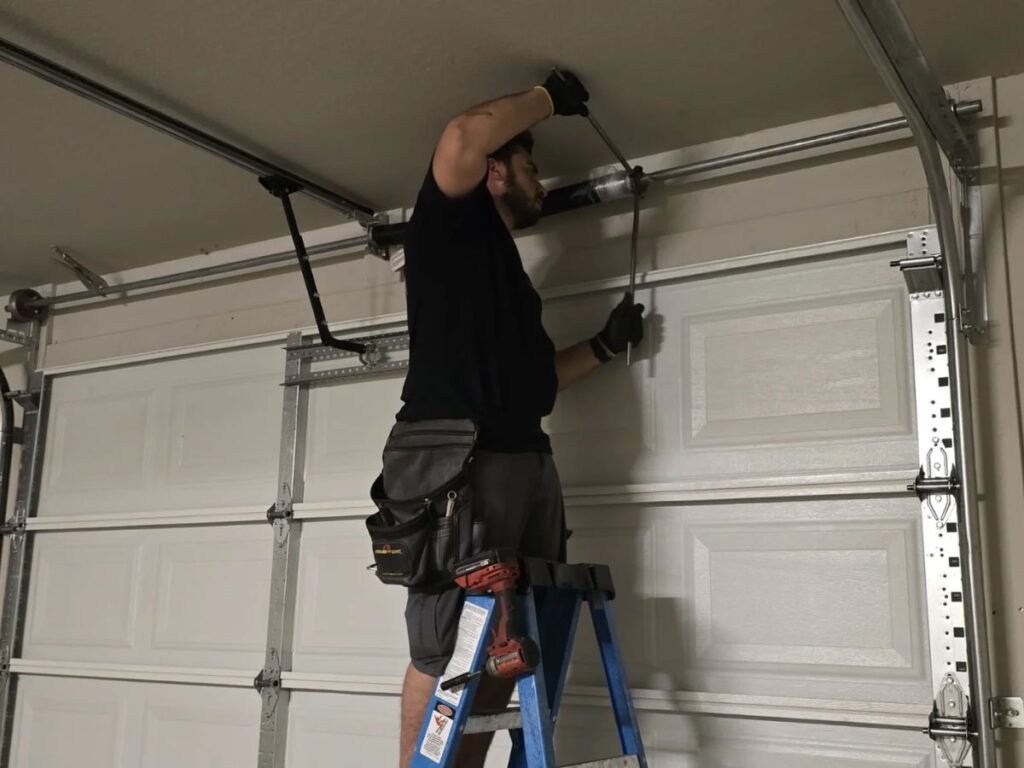
3. Door Reverses Midway
A maintenance lead once showed us a door that kept stopping halfway before climbing right back up. No error messages, no stuck parts, just a quiet refusal to close.
This kind of behavior confuses a lot of people. The system isn’t jammed or broken, but something small is triggering a safety response.
Let’s break down why this happens and how we usually solve it.
What Might Be Causing It
- Blocked or Misaligned Sensors: The photo-eye sensors near the floor create an invisible safety beam. If something breaks that beam or the sensors aren’t aligned, the door won’t close.
- Close-Force Settings Are Too Low: This setting tells the opener how much resistance is allowed. If it’s too sensitive, even light pressure will trigger a reversal.
- Track Problems or Stiff Rollers: A slight bump or drag along the track can confuse the motor. It may treat resistance as an obstruction and pull the door back up.
- Cable Tension Issues: Worn or uneven cables can throw off balance. That imbalance causes the system to stop or reverse unexpectedly.
How We Fix It
- Inspect the Sensors: We look for dust, cobwebs, or anything else that might block the beam. Then we gently clean the lenses and realign them if needed.
- Check the Indicator Lights: Both sensors should show a solid light. If one is blinking or off, the system won’t allow the door to close.
- Adjust the Close-Force Setting: Using the opener’s control panel or dials, we make a small increase in the force setting. This helps the door close fully without pushing too hard.
- Inspect Tracks and Cables: We look for signs of debris, wear, or imbalance. If the cables are stretched or uneven, we reset or replace them as needed.
Someone once joked, “It’s like my garage door is afraid to shut.” In their case, a loose broom was swinging in front of the sensor every time the wind picked up. A quick reposition and the problem disappeared.
Final Tips
- Clean and Align the Sensors Often: Even small debris or misalignment can stop the door from closing. A quick wipe-down can solve the issue.
- Watch for Blinking Sensor Lights: These lights are early indicators that something’s wrong. Solid lights mean the sensors are working.
- Adjust Close-Force Settings Slowly: Make careful changes to avoid putting too much strain on the system. Start with small increases.
- Keep Tracks Clear and Listen for Friction: Dirt, pebbles, or tight rollers can cause drag. When in doubt, listen to unusual sounds during movement.
A door that reverses mid-cycle is doing its job but often for the wrong reason. With a few small checks, most of these issues can be fixed in minutes.
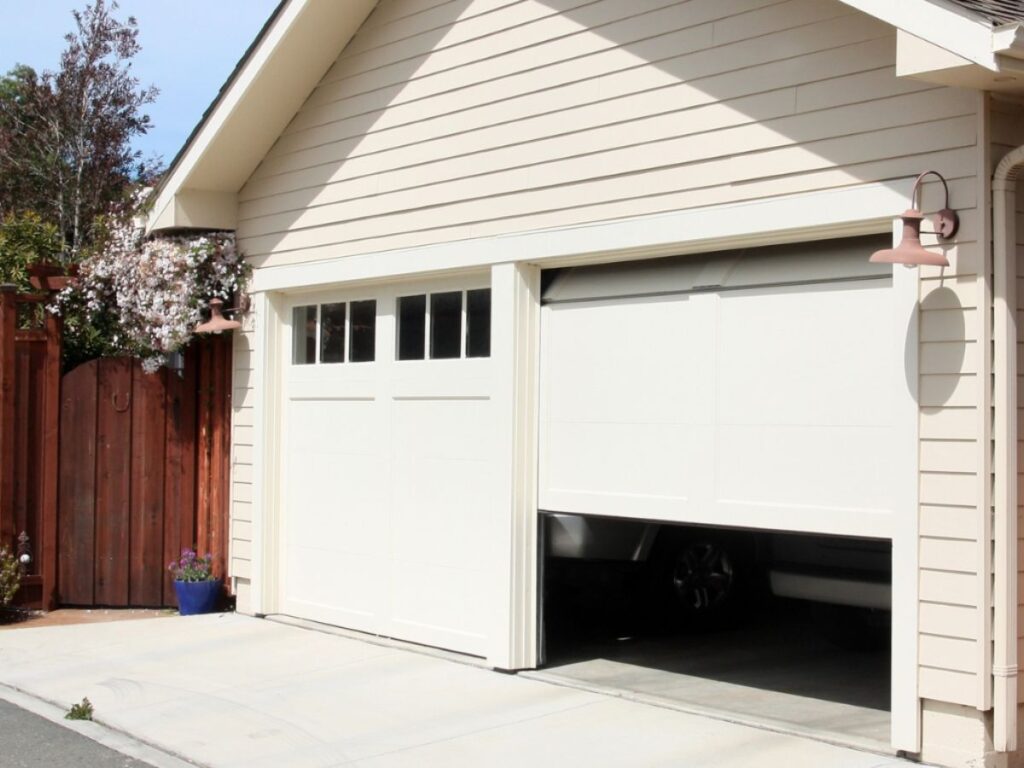
4. Door Off Track
A misaligned garage door isn’t always obvious at first. But when one side starts to rise faster or it jams at an angle, something is clearly wrong. In most cases, this means the rollers have slipped out of the track. If left unchecked, it can damage more than just the door.
Let’s look at what causes this and why it needs fast attention.
What Might Be Causing It
- Something Hits the Door: Even a light bump from a vehicle or cart can push the rollers out of alignment. The impact doesn’t have to be strong to cause damage.
- Loose or Broken Rollers: These keep the door moving smoothly. If one pops loose or wears down, the entire system shifts.
- Bent or Damaged Tracks: Tracks need to stay straight and firm. If they’re dented or warped, the rollers won’t stay in place.
- Cable Problems: When a cable slips or breaks, it creates uneven tension. This causes the door to tilt and may force it off track entirely.
How We Fix It
- Stop All Movement: We disconnect the opener to prevent the system from engaging while we work. This keeps the door from shifting unexpectedly.
- Realign the Rollers: If they’re still intact, we guide them back into place with care. We also check for any signs of wear or damage.
- Check the Track: Any bent or dented sections are either reshaped or replaced. Smooth tracks are key to safe movement.
- Inspect All Parts: We review the cables, brackets, and drums for wear or failure. If anything looks off, we replace it before reactivation.
- Tighten All Hardware: A loose bolt can cause more problems than it seems. We secure everything to keep the track stable under movement.
One manager described the problem as “the door leaning on one leg.” It turned out a delivery truck had nudged it just enough to knock a roller out of place. We got it realigned, reinforced the weak point, and the system ran smoothly again.
Final Tips
- Never Force the Door: If it looks crooked or jammed, don’t try to open or close it. Forcing it can damage the tracks, cables, or opener.
- Check Alignment Early: If the door starts leaning or stuttering, inspect the tracks before it gets worse.
- Keep Rollers and Hardware Maintained: Worn parts create weak spots. Regular maintenance prevents sudden failure.
- Call for Help Promptly: A small shift can quickly affect the whole system. The sooner it’s fixed, the lower the repair cost.
A door off track is more than an inconvenience. It’s a safety concern and one that’s best handled before it leads to further damage.
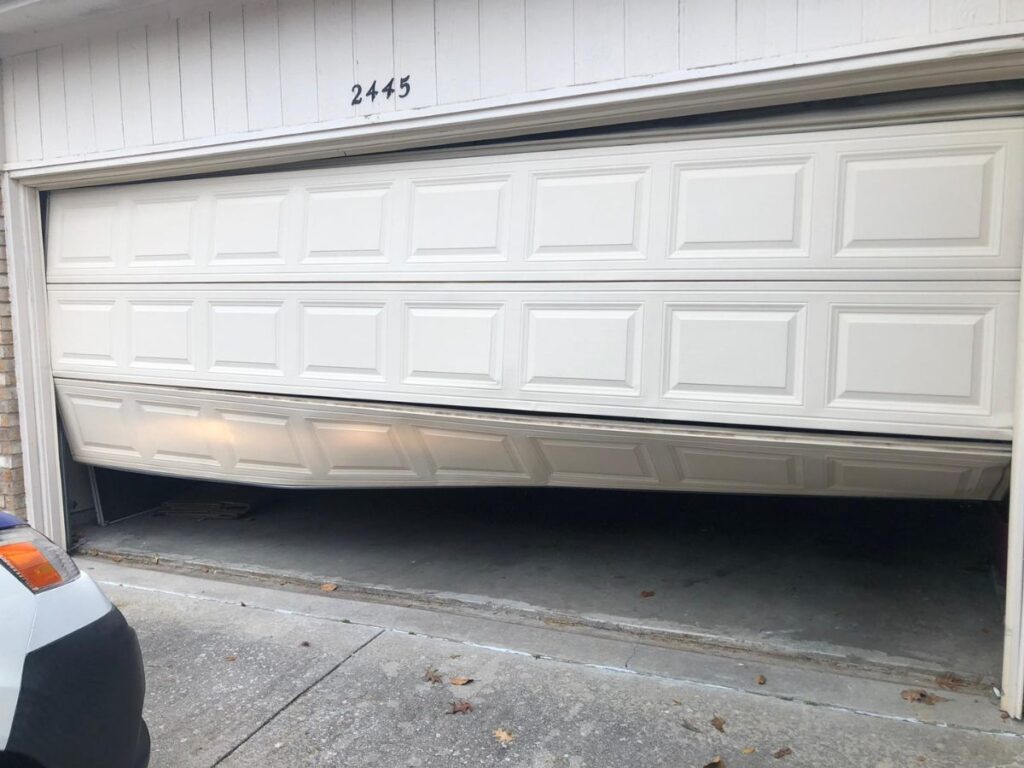
5. Unresponsive Remote or Wall Button
A non-working remote can be annoying. But when the wall button doesn’t respond either, it’s a sign that something deeper might be going on. We’ve seen this issue across many properties villas, workshops, guesthouses. And in most cases, the fix is easier than expected once you know where to start.
Let’s walk through the likely causes and how we troubleshoot them.
What Might Be Causing It
- Dead Remote Battery: Batteries wear out faster than expected, especially in cold or humid environments. A weak signal or no response is usually the first clue.
- No Power to the Opener: If the unit is unplugged or a breaker has flipped, the entire system stays inactive. This is one of the most common causes.
- Disconnected Wall Button Wire: If the wire behind the wall control is loose or broken, it can’t send the signal to the opener. This can happen from vibrations or accidental contact.
- Remote Lost Its Programming: Some remotes disconnect from the opener after a power outage or reset. Without syncing, they won’t work.
- Faulty Logic Board: The control board inside the opener receives all the signals. If it fails, neither the wall button nor remote will work.
How We Fix It
- Check the Outlet: We test the power source by plugging into another device. If there’s no power, we check the circuit breaker or wall switch.
- Test the Wall Button: If the motor has power but the button is silent, we remove the faceplate and check the wire connections.
- Change the Remote Battery: It’s a quick step that often solves the problem. We always keep fresh batteries on hand.
- Reprogram the Remote: Most openers have a “Learn” button for syncing. We follow the correct steps based on the opener’s brand.
- Inspect the Logic Board: If none of the above works, we test the internal control board. If it’s damaged, replacement is usually the best option.
In one case, maintenance tech kept pressing the remote with no luck. When we arrived, we found the opener unplugged accidentally knocked loose during storage cleanup. A simple fix, but easy to overlook.
Final Tips
- Try Both Controls: If both the wall button and remote fail, check power first. This helps you narrow the problem quickly.
- Don’t Forget the Outlet: The opener might be on a different circuit than the garage lights. Just because lights work doesn’t mean the opener has power.
- Swap the Remote Battery: It’s one of the fastest ways to rule out a common issue. Batteries degrade even without frequent use.
- Call for Help if Wiring or Boards Are Damaged: If the logic board or wall control wiring looks burned or loose, avoid DIY repairs. These need proper tools and training.
A quiet door doesn’t always mean a major failure. Sometimes, it’s just one small thing standing in the way of everything working like it should.
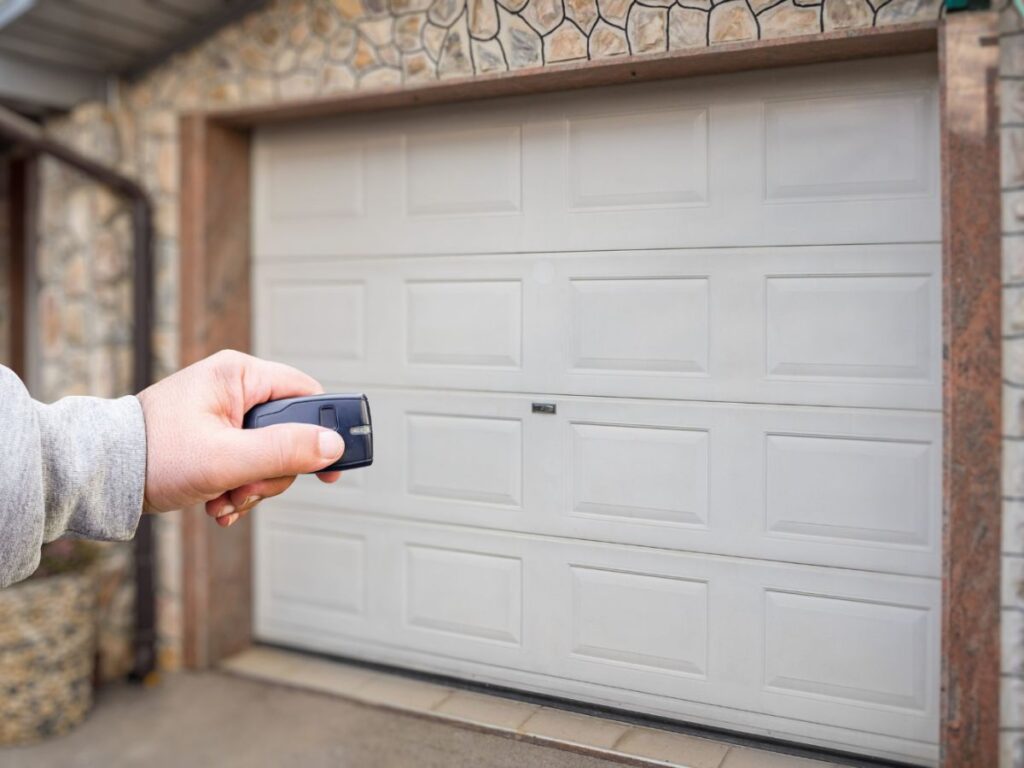
6. Broken Springs
We once stepped into a garage where the door wouldn’t move an inch. The homeowner had heard a loud snap the night before but didn’t think much of it. That sound turned out to be a broken spring, something we see regularly across homes, villas, and guest facilities.
Springs are what carry the real weight of the door. When one breaks, the system can’t do its job.
What Might Be Causing It
- Wear Over Time: Springs are built for a fixed number of cycles. With daily use, even good springs eventually wear out.
- Rust or Corrosion: Moisture in the garage or poor ventilation can eat away at spring coils. Over time, this weakens the metal.
- Unbalanced Movement: If one side of the door pulls harder than the other, that spring takes more stress. It wears out unevenly and fails sooner.
- Poor-Quality Materials: Springs made from lower-grade metal don’t last as long. We’ve seen them fail after just a few years.
There are two main types of garage door springs:
- Torsion Springs: These sit above the door and twist to create force.
- Extension Springs: Located on the sides, these stretch when the door closes.
Both types operate under high tension and need to be handled with care.
How We Fix It
- Disconnect the Opener: First, we prevent the door from trying to move during repair. This avoids damage or injury.
- Inspect the Springs: A clean break or visible gap in the coil confirms the problem. We check both sides, even if only one appears damaged.
- Release Tension Safely: We use professional-grade tools to unload the tension. Doing this by hand or with makeshift tools is risky.
- Install a Matching Spring: Every spring must match the door’s size and weight. The wrong fit can cause early failure or imbalance.
- Balance and Test the System: Once installed, we test the door manually. Smooth, even movement means the repair is done right.
In one case, a spring had snapped overnight and slammed against the metal track. The client didn’t realize anything was wrong until the next morning, when the opener strained and stopped halfway. That kind of force doesn’t go unnoticed.
Final Tips
- Don’t Try to Fix Springs Yourself: They store a lot of energy and can be dangerous. Leave it to train technicians with the right tools.
- Watch for Sudden Weight Changes or Loud Pops: If the door suddenly feels heavier or you hear a loud snap, assume it’s a spring.
- Avoid Using the Opener Until It’s Repaired: Forcing the door up can damage the motor. It’s safer to leave it in place.
- Ask About High-Cycle Springs: If your garage sees heavy daily use, upgraded springs are worth considering. They’re built to last longer.
Springs are the hidden strength behind every garage door. When they fail, nothing else can work properly. Handling the problem early keeps the system safer and extends the life of your equipment.
7. Frayed or Snapped Cables
A garage door that moves unevenly or gets stuck partway often points to a cable issue. Sometimes there’s a pop, a shift in balance, and then everything stops. Cables carry more load than most people realize. When one gives out, the door can jam, tilt, or fall off balance completely.
Several conditions can cause a cable to wear down or snap without warning.
What Might Be Causing It
- Normal Wear and Tear: Over time, steel strands begin to fray. Years of tension and movement slowly wear them down.
- Rust and Moisture: Humid garages or leaks can corrode the cable from the inside. This weakens the metal and makes snapping more likely.
- Spring Damage: When a spring breaks, the full load shifts to the cable. That extra strain often causes it to fail soon after.
- Pulley or Drum Problems: A misaligned drum or faulty pulley can cause the cable to slip, overlap, or bunch up. Left unchecked, it damages the cable quickly.
Cables don’t always show visible damage right away. Sometimes the problem is hidden behind the track or only appears under tension.
How We Fix It
- Disconnect the Opener: This stops the motor from trying to lift or lower a crooked door. Moving the door with a damaged cable is risky.
- Secure the Door in Place: We brace the door or clamp the tracks. This prevents sudden drops while repairs are made.
- Remove the Damaged Cable: We inspect the full run of the cable and check nearby hardware for signs of stress.
- Install a Matching Replacement: The new cable must match the size and type of the original. Proper tension keeps the system balanced.
- Test the Door’s Movement: We lift the door manually to confirm smooth and even motion. If everything checks out, we reconnect the opener.
During a service call at a multi-unit residence, the garage door appeared fine from the outside. But inside, the left cable was completely unraveled behind the track. The door had started dragging slightly, yet the imbalance wasn’t obvious until the system stopped working entirely.
Small shifts like that are easy to miss until they force a bigger repair.
Final Tips
- Watch for Uneven Movement: If one side rises or lowers faster, check the cables. That’s often the first sign of trouble.
- Inspect the Bottom Brackets: Fraying usually starts low where the cable bends and flexes the most.
- Avoid Using the Door if It’s Leaning or Scraping: Forcing it can damage the track, opener, or even cause it to fall.
- Call for Help If a Cable Is Loose or Off the Drum: Handling cable repairs without the right tools can lead to more damage or injury.
Garage door cables don’t fail often, but when they do, they throw the entire system out of balance. Spotting issues early and acting fast keeps both the door and your team safe.
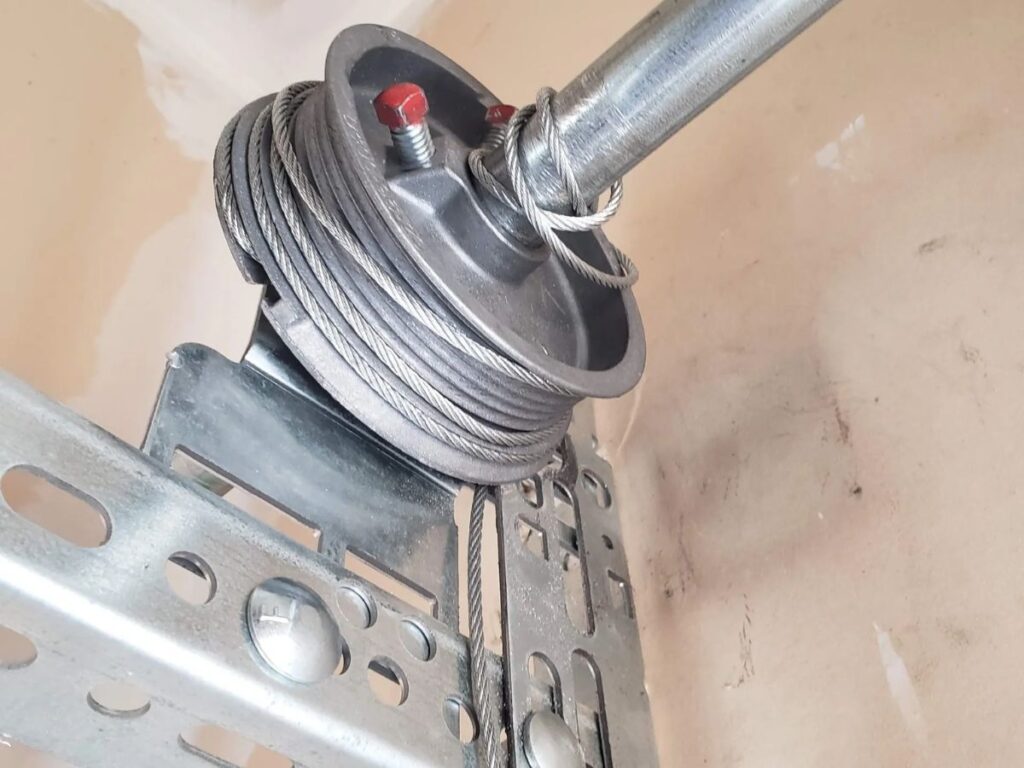
8. Damaged Weather Seal
You might notice cold air sneaking in or dust collecting near the corners of the garage. Sometimes there’s water on the floor, even when the door appears closed tight. These are signs the bottom weather seal has worn out. It’s a simple strip of rubber, but once it fails, your garage is exposed to air, water, and pests.
Let’s break down what typically causes this kind of damage.
What Might Be Causing It
- Age: Rubber or vinyl seals naturally break down over time. Years of pressure and movement cause them to flatten and crack.
- Sunlight: UV exposure dries out the material. Once it turns brittle, it can’t flex or seal properly.
- Cold Weather: Low temperatures stiffen the seal. When the door moves, that stiffness can cause splits or breaks.
- Friction Against the Ground: Uneven floors or rough surfaces wear the seal faster. Repeated scraping creates weak spots and gaps.
Even small tears can allow water, bugs, and wind to slip through, especially along the corners.
How We Fix It
- Lift the Door Fully: This relieves pressure on the seal. It also allows full access to the bottom edge for removal.
- Remove the Old Strip: Depending on the door, the seal may slide out of a track or be fastened in place. We remove it carefully to avoid damaging the frame.
- Clean the Bottom Edge: Any dirt, glue, or debris is scraped away. A clean surface helps the new seal sit evenly and hold longer.
- Install the New Seal: We cut it to match the exact width of the door. Once pressed into place, we confirm that it sits flush with the floor.
- Test the Seal: After lowering the door, we check for light, airflow, or visible gaps. If needed, we make small adjustments for a tighter fit.
We also check the seals on the top and sides. If those are cracked or missing, we suggest replacing them while the bottom seal is being repaired.
Final Tips
- Look for Light Under the Door: If sunlight is visible along the bottom, the seal isn’t doing its job. Even a narrow gap matters.
- Check by Touch: The seal should feel soft and flexible. If it feels brittle or cracked, it’s time to replace it.
- Listen to Dragging Sounds: A scraping noise may mean the seal is wearing unevenly or the floor has shifted.
- Keep It Clean: Built-up dirt shortens the seal’s life. A quick wipe-down from time to time makes a difference.
The weather seal plays a big role in keeping your garage protected. Replacing it on time helps you avoid water damage, drafts, and pest issues down the line.
9. Slow or Delayed Movement
You hit the remote and wait. Nothing happens at first, then the door slowly begins to move like it’s hesitating.
Some days it works fine. Other times, it drags or pauses, and the delay becomes harder to ignore. Most of the time, this isn’t a major failure it’s small issues building up over time.
A few common problems tend to show up when a garage door starts slowing down.
What Might Be Slowing It Down
- Cold Weather: Low temperatures thicken the grease and slow motor response. The entire system starts to drag more than usual.
- Old Garage Door Opener: Motors wear down after years of use. They take longer to respond and can struggle to start.
- Dry Rollers or Tracks: Lack of lubrication increases resistance. That makes the door feel heavier and slows the movement.
- Unbalanced Door: A weak spring or loose cable adds extra weight. When the opener works harder than it should, the door moves slower.
- Power Issues: Voltage dips or loose wires cause slow signals and weak motor output. This shows up as hesitation or stop-start movement.
A quick way to test? Wait for a warm day. If the door moves better, it’s likely weather-related. If it stays slow, mechanical issues might be the cause.
How We Fix It
- Listen to the Motor: If it hums for a few seconds before moving, that’s a sign it’s struggling to get going.
- Check Opener Settings: Some models have speed settings. We make sure it hasn’t been lowered accidentally.
- Lubricate Moving Parts: We check hinges, rollers, and tracks for dryness. A small amount of garage-rated grease can make a big difference.
- Test Door Balance: We disconnect the opener and lift the door by hand. If it feels too heavy or uneven, the spring may need adjustment.
- Inspect the Power Supply: Weak or loose connections can reduce performance. We test the wiring and voltage coming to the opener.
At a recent job, a door looked completely fine but moved at half speed. The cause? Worn rollers and a tight spring that hadn’t been adjusted in years. Once those were cleaned, greased, and balanced, the door ran like new.
Final Tips
- Lift It by Hand: A heavy or uneven feel often means the balance is off. That affects how well the opener performs.
- Pay Attention to Cold Weather: If the door slows down in low temperatures but works better later, grease or weather might be the issue.
- Lubricate the Tracks and Rollers: Use a silicone-based or lithium garage door lubricant. Avoid household sprays like WD-40.
- Don’t Ignore the Delay: If it worsens over time, the opener may be wearing out. Replacing it early can prevent full breakdowns.
A garage door doesn’t have to be fast but it should move consistently and without strain. If yours starts hesitating, it’s a sign that something simple needs attention.
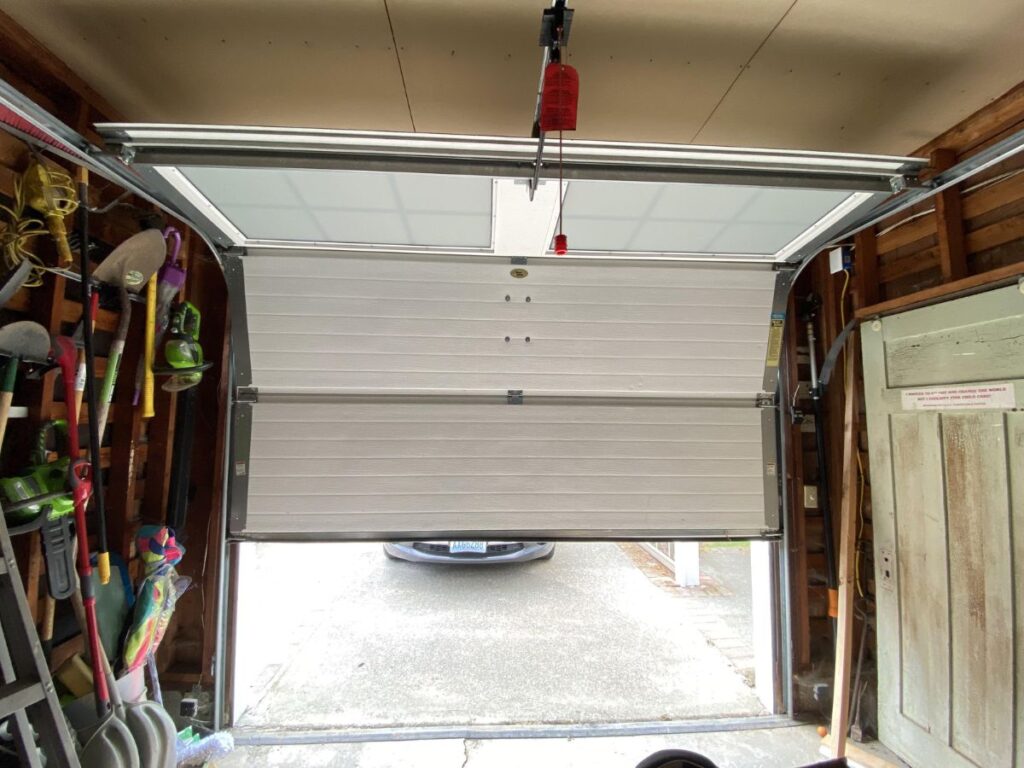
10. Door Gets Stuck Midway
The garage door starts to move, then suddenly stops halfway. No noise. No warning. Just frozen in place.
Sometimes it picks up again after a few clicks. Other times, it stays stuck tilted or uneven on the track. It’s the kind of issue that shows up out of nowhere and quickly becomes disruptive.
This type of problem usually comes from something small, but left unchecked, it can wear down the system fast.
What Might Be Causing It
- Blocked or Dirty Tracks: Even a small buildup of dirt or debris can stop the rollers. Dents or bends in the track can also create resistance.
- Worn Rollers or Hinges: When parts dry out or wear down, the door struggles to move smoothly. Friction builds until it stops mid-cycle.
- Spring or Cable Tension Is Off: An imbalance causes uneven lifting. That can make the door tilt and catch on the track.
- Motor Overheating or Weak Signal: If the opener is too hot or not getting full power, it may pause or shut down.
- Sensor Misalignment: Even if the door moves partway, a faulty sensor can interrupt its cycle if it thinks something’s in the way.
It’s not always obvious. Some issues hide behind normal movement until the door finally locks up.
How We Fix It
- Check the Tracks: We clear out any dirt, small objects, or buildup. If the track is bent or dented, we straighten or replace the section.
- Inspect Rollers and Hinges: We look for flat spots, cracks, or dry joints. Damaged parts are replaced, and dry ones are lubricated.
- Test Door Balance: We disconnect the opener and lift the door manually. If it shifts or pulls unevenly, spring or cable tension may be the cause.
- Examine the Opener: If it’s warm to the touch or stops mid-cycle often, we let it cool and check for worn components or loose wiring.
- Verify the Sensors: We confirm both lights are solid and aligned. Even small objects in the path like packaging or tools can interfere.
In one job, a garage door kept freezing just before closing. Everything seemed normal until we spotted a broom handle barely brushing the sensor beam. Once removed, the door worked like nothing was ever wrong.
Final Tips
- Note Where It Stops: Consistent stopping points can help trace the issue. That spot may point to a jam, bent track, or unbalanced movement.
- Check the Track for Debris: Even small screws, sticks, or pebbles can block the rollers.
- Test the Door by Hand: A stiff or uneven feel could mean spring or cable trouble. If it feels heavy, avoid forcing it.
- Let the Opener Cool: If it feels hot or starts and stops randomly, rest it for a few minutes before trying again.
With Vallisco projects, we often spot minor track obstructions causing doors to stop mid-movement things as small as a broom bristle can throw the whole system off.
A stuck door doesn’t always mean something’s broken. But it always means something’s off. Catching it early helps prevent damage and keeps your garage running the way it should.
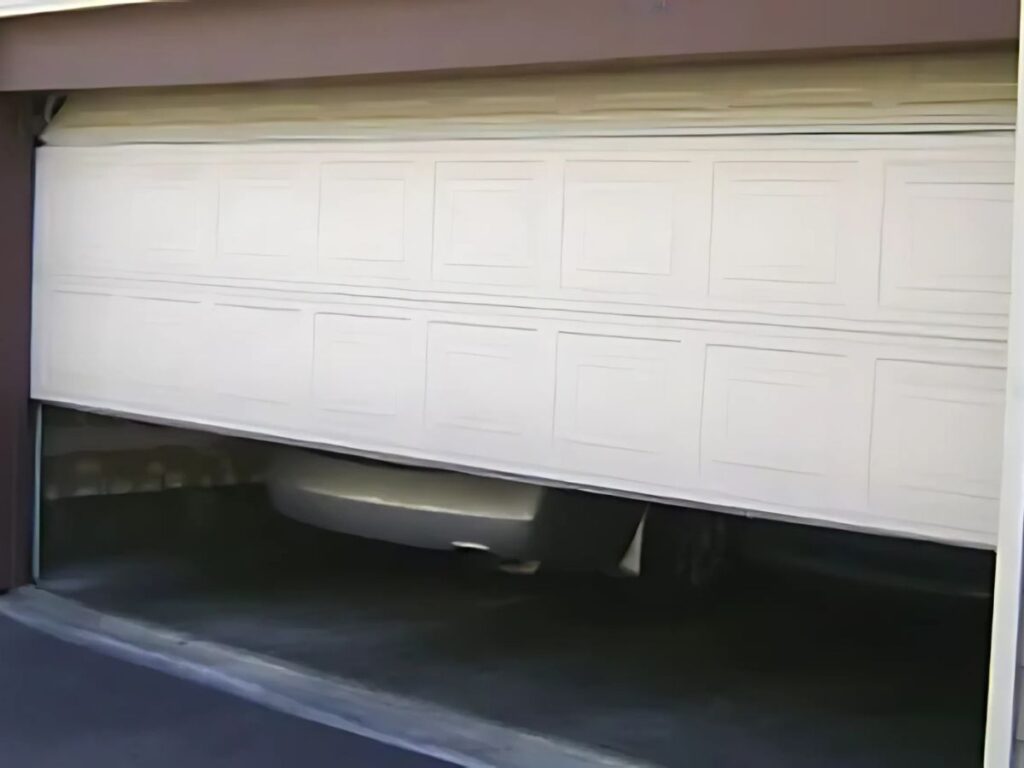
Conclusion
Garage door acting up? Now you know why.
From stuck doors to strange noises, we’ve covered the top issues and how we repair them.You’ve got the tools. The checklist. The confidence.
I’ve seen these problems happen to people who thought they were alone in it. You’re not.
If your door is slowing down or failing mid-open, don’t wait. Small problems become big ones fast.
Ready to make your garage work like it should?
Contact Vallisco today.
Explore More Helpful Resources
There’s more to explore! Check out our additional product selections to find exactly what you’re looking for:
Still haven’t found what you’re looking for? Don’t hesitate to contact us. We’re available around the clock to assist you.







